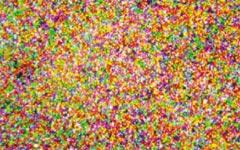Captured in colour: rare photographs from the First World War - Elusive colour: The autochrome
In 1904 the Lumière brothers, Auguste and Louis, who were already successful businessmen, patented the idea of using a screen plate made of a random mosaic of dyed starch grains. This developed their concept into the autochrome. In 1907, with the autochome already in production at their Lyon plant, they presented it to the Photo-Club de Paris. The photographic world was captivated.
Unlike other colour screen plate systems, the autochrome was a single piece of glass comprising both the colour screen and the photographic emulsion, or coating. The colour screen was made up of dyed potato starch grains that had been separated to a uniform size, dyed red-orange, green and blue-violet, and thoroughly mixed together. The mixture was applied to a varnished glass plate while the varnish was still tacky. The excess mixture was brushed off and the plate passed between steel rollers to flatten the grains, resulting in tiny colour filters between 0.006 and 0.025 millimetres across. Any space between the filter elements was filled with carbon powder. The plate was then varnished, and when dried, a standard black-and-white emulsion was overlaid.

Detail of autochrome showing the dyed grains
The plate was exposed in reverse; that is, with the glass side of the plate to the lens so that light entering the camera passed first through the colour filters before exposing the negative. The exposed plate would then be processed in reverse, so that the image produced was a positive. When viewed with a light source behind it, a colour image was displayed.

Magnified view of the colour screen used in the autochrome colour photography system.